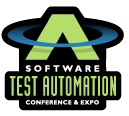Software Test Automation Spring 2002

PRESENTATIONS
|
Rooting Out System Bottlenecks in Web Applications
One of the toughest challenges in testing and quality assurance today is eliminating the performance "bottlenecks" in your Web system. This session highlights a number of common problems that affect most Web systems. Things such as inefficient SQL, slow networks, improper firewall setup, bad connection pooling schemes, and failure to design for scalability are all factors that can degrade your system's performance. |
|
|
Software Test Automation 2002: A Case Study In Automating Web Performance Testing
Key points from this presentation: define meaningful performance requirements; we're always searching for the maximum number of users, design bottlenecks, and performance tuning points; changing your site (hardware or software) invalidates all previous predictors; reduce the number of scripts through equivalence classes; don't underestimate the hardware needed to simulate the load; evaluate and improve your skills, knowledge, tools, and outsourced services; document your process and results so that others may learn from your work; use y |

Lee Copeland, Software Quality Engineering |
|
Software Test Automation Spring 2002: Test Automation on a Shoestring: Doing More with Less
Want to automate your tests but don't have the budget for big-league tools? Elisabeth Hendrickson offers case studies where test automation was accomplished with simple tools for small budgets. She delivers practical advice for creating the automation you need from the tools you already have or can easily get your hands on. Fact is, everything you need to get started is probably right in your "kitchen drawer." |

Elisabeth Hendrickson, Quality Tree Software, Inc. |
|
Software Test Automation Spring 2002: Test Automation With Action Words: A Practical Experience
Action Word Testing. This concept illuminates testing as an action, a process, an art. Learn how Action Word Testing can be applied to deal with critical test issues such as lack of functional knowledge of a system under test; instability of the design during test development; and automation of 100% of the functional or technical tests. Hans Buwalda uses a financial exchange that's introduced a new electronic trading system to demonstrate Action Word Testing (approximately 15,000 tests). |
Hans Buwalda, LogiGear |
|
Taking Test Automation Mainstream
By now, most test organizations have implemented at least one test automation tool. However, the success of these tools is by no means guaranteed. Why is it that these products often fail to meet their potential? What can managers do to increase the tool's return on investment? Andrew Pollnew helps you with ways to ensure that tools support rather than hinder you. He discusses a number of common-but-flawed approaches to automation, then explains how to change them. |

Andrew Pollner, ALP International Corporation |
|
Test Tool Implementation Risks and Rewards
Did you know that an alarmingly high percentage of the test tools purchased are never successfully implemented? Many organizations could benefit tremendously from the effective use of testing tools; problem is, they're not sure how to go about it. This session examines a dozen or more of the most common pitfalls encountered in the acquisition and implementation of testing tools and offers suggestions to avoid these mistakes. |

Rick Craig, Software Quality Engineering |
|
Test, Observe, and Assess Embedded Applications During Development
Facing the paradox of developing better applications faster, developers of real-time, embedded, and networked applications have no choice but to use automated testing and runtime observation technologies. This session introduces you to processes and technologies designed to automate the unit, validation, and integration testing of everything from individual functions to complete distributed systems in embedded software applications. |
|
|
Testing in the Fast Lane: Automated Acceptance Testing in an eXtreme Programming Environment
Are you looking to apply the values of eXtreme Programming (XP) to test automation? In eXtreme Programming Explained, Kent Beck compares XP to driving a car-meaning the team must make constant corrections to stay on track. This includes plotting the course, establishing check points, tracking progress, and occasionally even asking for directions. But XP test professionals have a need for speed given their tight deadlines, so is this much process really possible? |

Lisa Crispin, BoldTech Systems |
|
The Business Case for Test Automation
In tight economic times, it's more important than ever to show a return on technology investments, including test automation. Unfortunately, management's expectations are usually unrealistic in that they expect immediate results and aren't prepared for the ongoing level of investment required after the tool is purchased. Find out why the benefits traditionally promised-reduced test resources and cycle time-are misleading and inaccurate. |

Linda Hayes, WorkSoft, Inc. |
|
The Past, Present, and Future of Software Test Automation Tools
Gregory Pope examines the past, present, and future of software testing tools. By contrasting the best thinking of ten years ago with what's happening today, he brings a clear and unique perspective to what the future might hold. Greg also provides insight into the successes and failures of once-promising tools. Using the historical factors that make test automation successful, he demonstrates how to pick tools that will be successful now and in the future. |

Gregory Pope, Gregory Pope Consulting |


